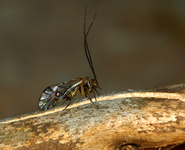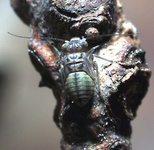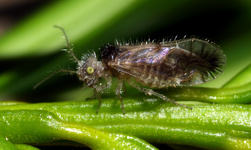Psocomorpha
Bark lice



This tree diagram shows the relationships between several groups of organisms.
The root of the current tree connects the organisms featured in this tree to their containing group and the rest of the Tree of Life. The basal branching point in the tree represents the ancestor of the other groups in the tree. This ancestor diversified over time into several descendent subgroups, which are represented as internal nodes and terminal taxa to the right.

You can click on the root to travel down the Tree of Life all the way to the root of all Life, and you can click on the names of descendent subgroups to travel up the Tree of Life all the way to individual species.
For more information on ToL tree formatting, please see Interpreting the Tree or Classification. To learn more about phylogenetic trees, please visit our Phylogenetic Biology pages.
close boxIntroduction
Psocomorpha is a large suborder, containing 24 families and approximately 3600 species (Lienhard and Smithers 2002). Psocomorphids live on tree bark, foliage, or leaf litter and eat lichens, algae, and fungus. They exhibit a range of interesting behaviors including stridulation, aggregation, sub-sociality, and nesting (Yoshizawa 2002).
Characteristics
- Head usually with rounded vertex
- antennae 13-segmented
- flagellomeres never annulated
- maxilla without stipito-galeal muscle
- hypopharyngeal filaments fused for most of their length
- labial palpus 1-segmented
- Forewing with nodus and thickened pterostigma
- nodulus hook-shaped, formed by truncated spines fused at their base
- CuP ending together with A1 at wing margin
- Thorax: Apex of first axillary sclerite usually with minute proximal process
- Female: Subgenital plate lacking median sclerite.
Psocomorpha Monophyly
The monophyly of Psocomorpha is well supported with both morpholgical and molecular data. The morphological synapomorphies uniting Psocomorpha are (from Yoshizawa 2002):
- head with rounded vertex
- absence of stipito-galeal muscle in head
- presence of proximal minute process at apex of first axillary sclerite
- presence of nodus on forewing
- thickened pterostigma on forewing
- a hooked nodulus on forewing fomed by truncated spines fused at their base
Molecular data supporting the monophyly are from the nuclear ribosomal gene 18S and mitochondrial genes 12S, 16S, and COI (Johnson & Mockford 2003).
References
Johnson, K. P. & E. L. Mockford. 2003. Molecular systematics of Psocomorpha (Psocoptera). Systematic Entomology 28: 409-40
Johnson, K. P., K. Yoshizawa, and V. S. Smith. 2004. Multiple origins of parasitism in lice. Proceeding of the Royal Society of London B 271: 1771-1776.
Lienhard, C. and C. N Smithers. 2002. Psocoptera (Insecta) World Catalogue and Bibliography. Mus?um d'Histoire Naturelle, Geneva, Switzerland.
Mockford, E. L. 1993. North American Psocoptera (Insecta). Gainesville, Florida: Sandhill Crane Press.
Mockford, E. L. 2005. Order Psocoptera: Psocids. Pp. 341-355 in C. A. Triplehorn and n. F. Johnson (eds.) Borror and DeLong's Introduction to the Study of Insects. Belmont, California: Thomson Publishing.
Smithers, C. N. 1996. Psocoptera. Pp. 1-80, 363-372 (Index) in A. Wells (ed.) Zoological Catalogue of Australia. Vol. 26. Psocoptera, Phthiraptera, Thysanoptera. Melbourne: CSIRO Publishing, Australia.
Yoshizawa, K. 2002. Phylogeny and higher classification of suborder Psocomorpha (Insecta: Psocodea:'Psocoptera'). Zoological Journal of the Linnean Society 136: 371-400.
Yoshizawa, K. 2005. Morphology of Psocomorpha (Psocodea:%u2019Psocoptera%u2019). Insecta Matsumurana 62: 1-44.
Information on the Internet
- Psoco Net: The Psocidologists' Home Page. The latest information on Psocoptera taxonomy and reserchers in the Psocoptera community, maintained by Dr. Kazunori Yoshizawa, Hokkaido University, Sapporo, Japan.
- Discover Life: Psocoptera Page
- Dr. Charles Lienhard. Psocid expert at the Natural History Museum, Geneva, Switzerland.
- Dr. Edward Mockford. Expert on Psocids of North America and beyond, Illinois State University.
- Dr. Kevin Johnson. Expert on molecular systematics of Psocids and parasitic lice, Illinois Natural History Survey.
- Emilie Bess. Research on Psocids of Hawaii and elsewhere, University of Illinois.
Title Illustrations

| Scientific Name | Psococerastis sp. |
|---|---|
| Location | Nokonoshima Island, Kyushu, Japan |
| Specimen Condition | Live Specimen |
| Identified By | K. Yoshizawa |
| Sex | Male |
| Life Cycle Stage | adult |
| View | dorsal |
| Size | 4mm |
| Copyright | © 2006 Kazunori Yoshizawa |
| Scientific Name | Ptycta conforma |
|---|---|
| Location | Nokonoshima Island, Kyushu, Japan |
| Specimen Condition | Live Specimen |
| Identified By | K. Yoshizawa |
| Life Cycle Stage | nymph (immature) |
| View | dorsal |
| Size | 3mm |
| Copyright | © 2006 Kazunori Yoshizawa |
| Scientific Name | Matsumuraiella radiopicta |
|---|---|
| Location | Japan |
| Specimen Condition | Live Specimen |
| Identified By | K. Yoshizawa |
| Life Cycle Stage | adult |
| View | lateral |
| Size | 3mm |
| Copyright | © 2006 Kazunori Yoshizawa |
About This Page
Page copyright © 2006
- First online 09 October 2006
- Content changed 11 October 2006
Citing this page:
Tree of Life Web Project. 2006. Psocomorpha. Bark lice. Version 11 October 2006 (under construction). http://tolweb.org/Psocomorpha/30218/2006.10.11 in The Tree of Life Web Project, http://tolweb.org/











 Go to quick links
Go to quick search
Go to navigation for this section of the ToL site
Go to detailed links for the ToL site
Go to quick links
Go to quick search
Go to navigation for this section of the ToL site
Go to detailed links for the ToL site